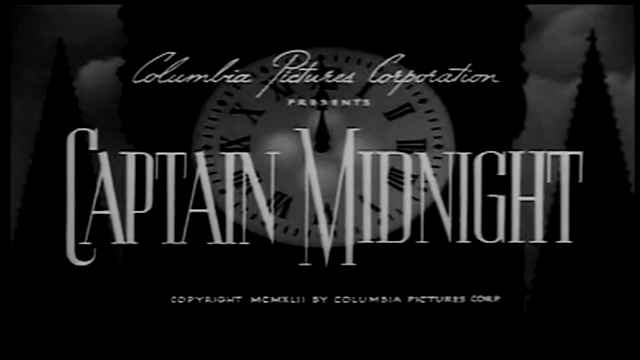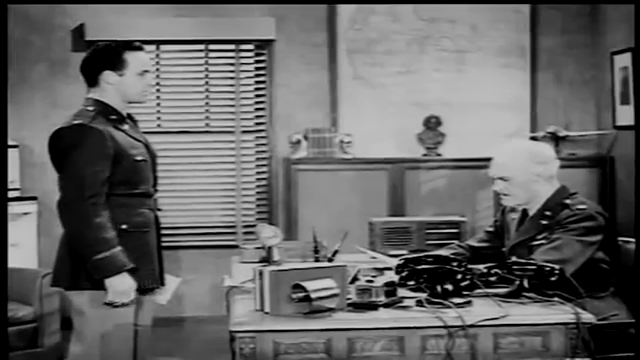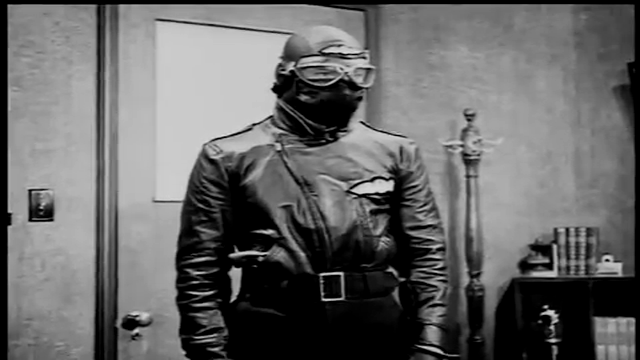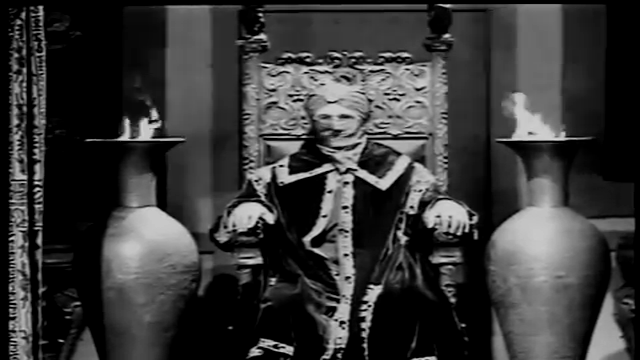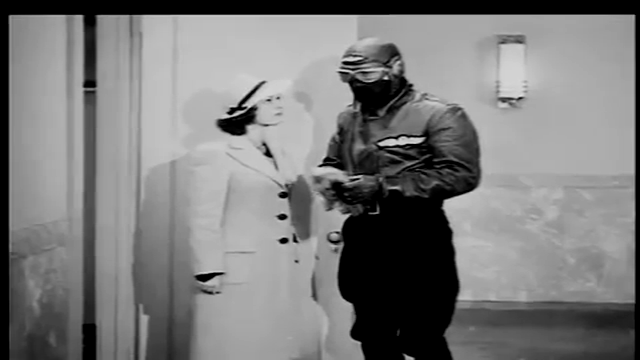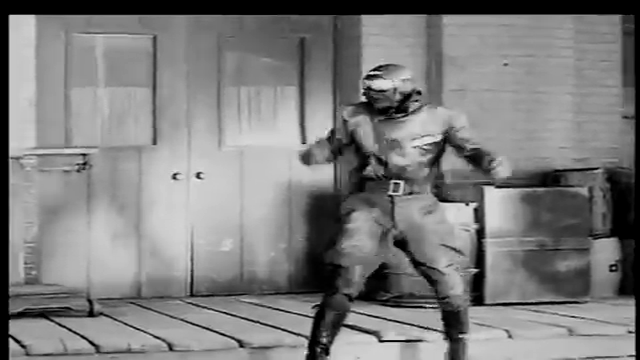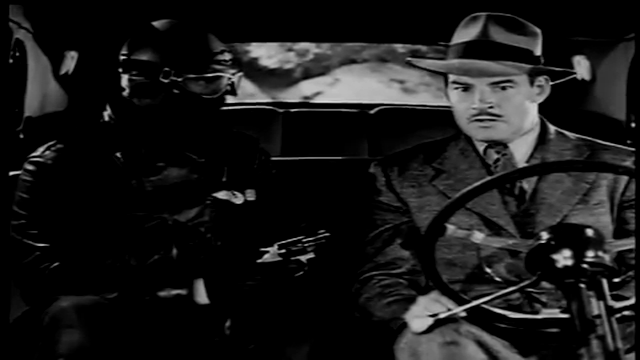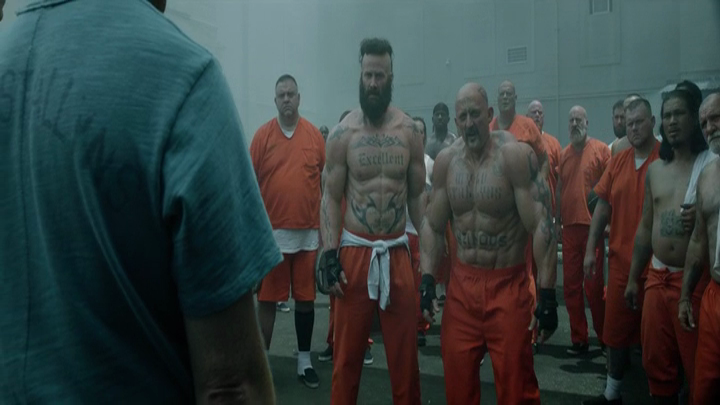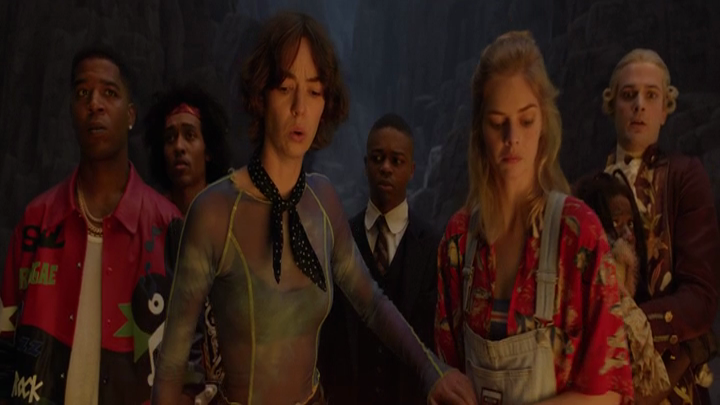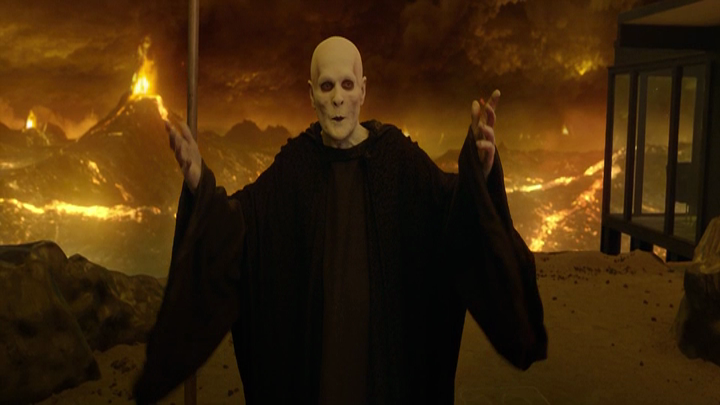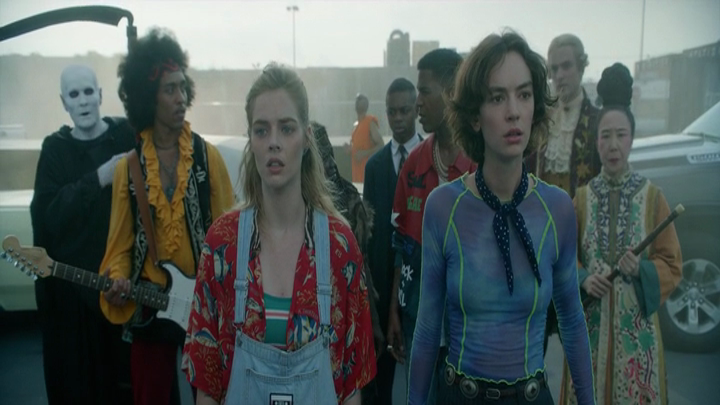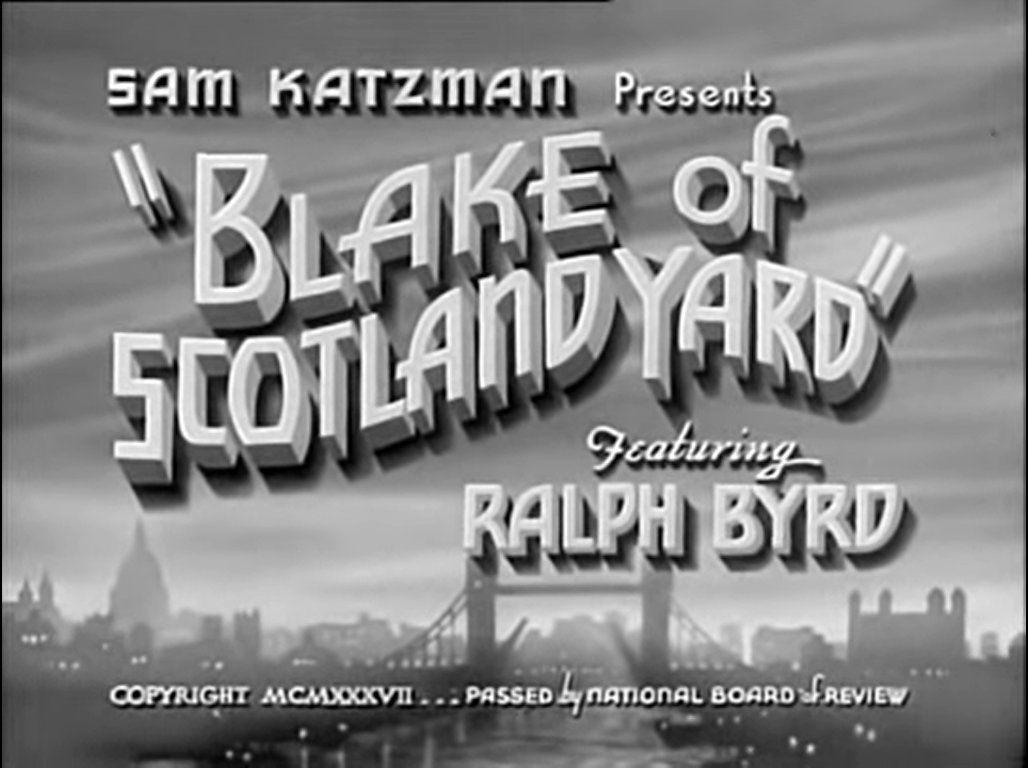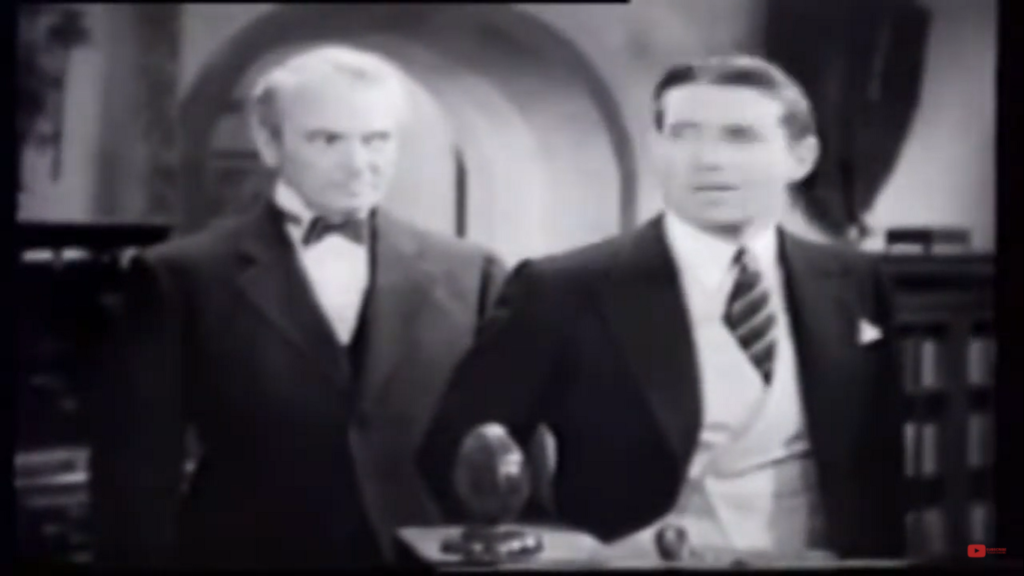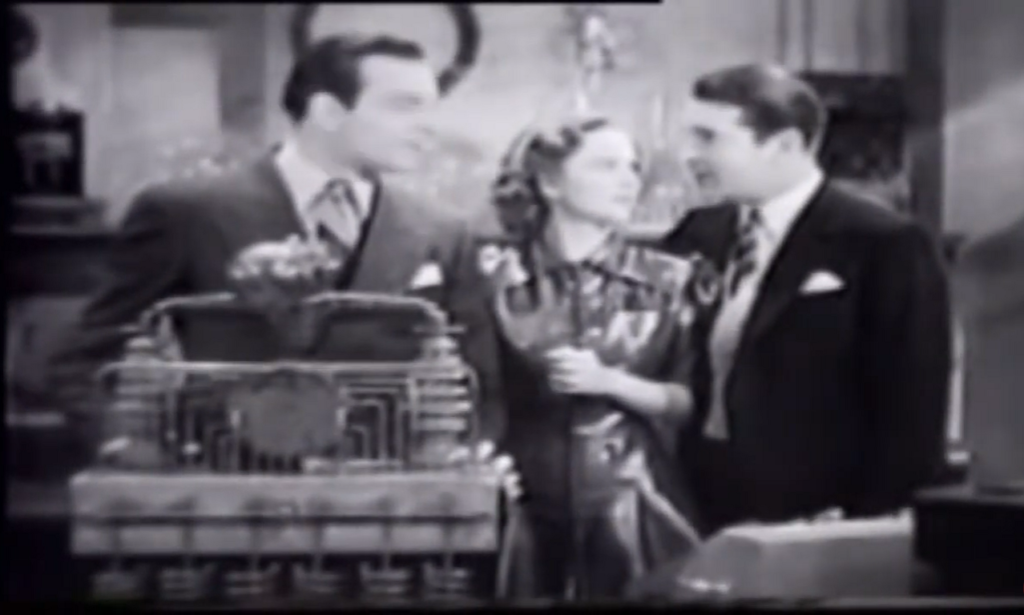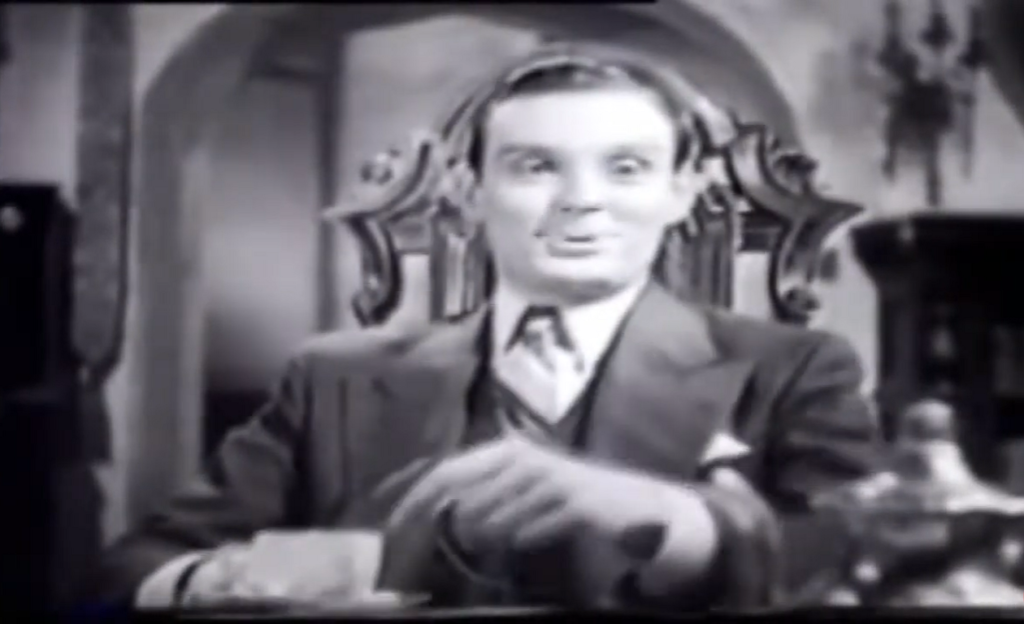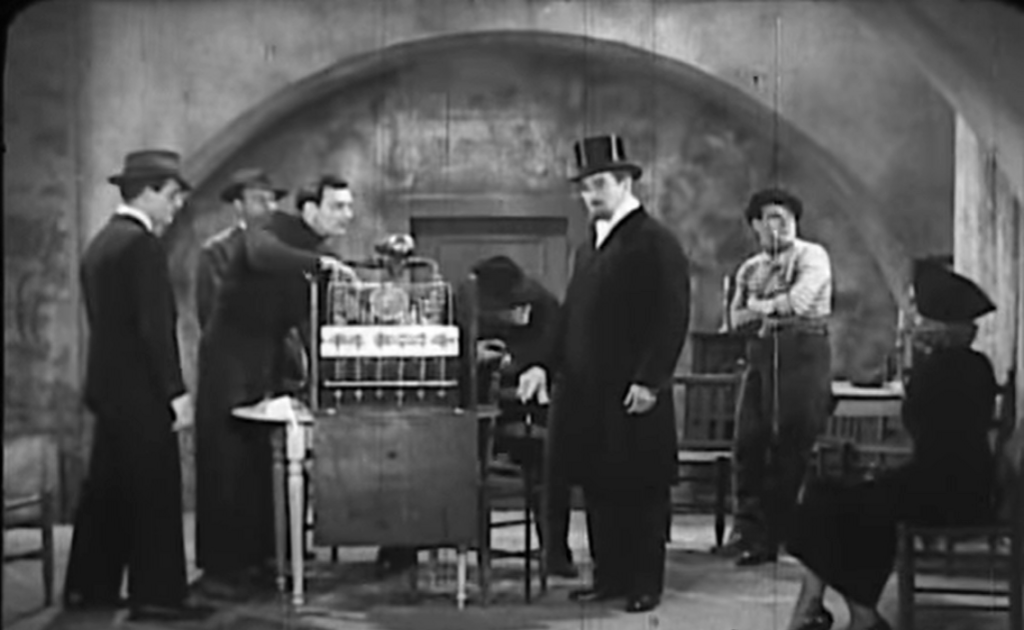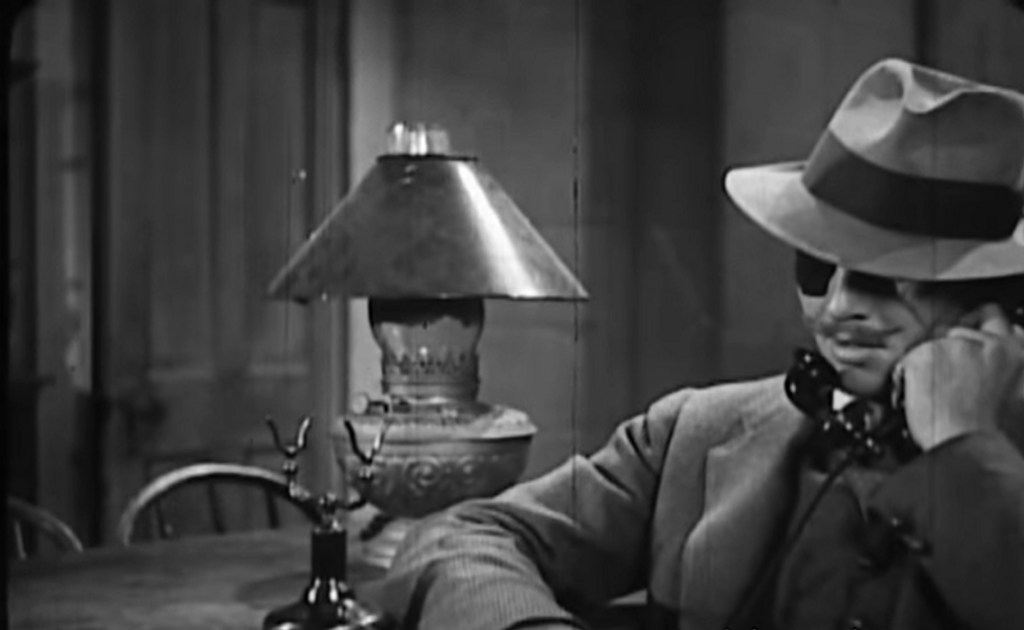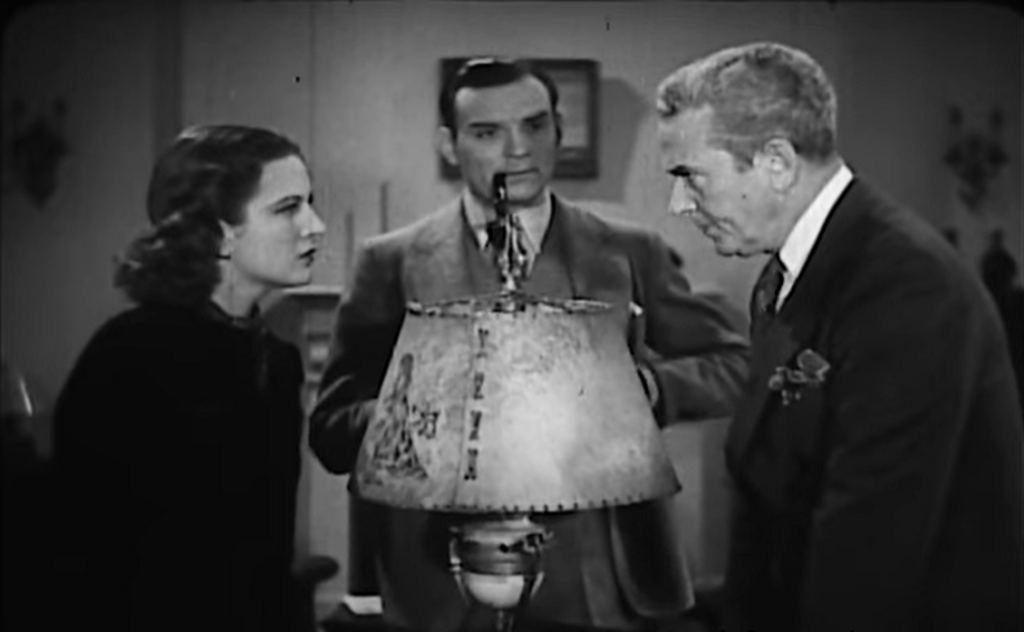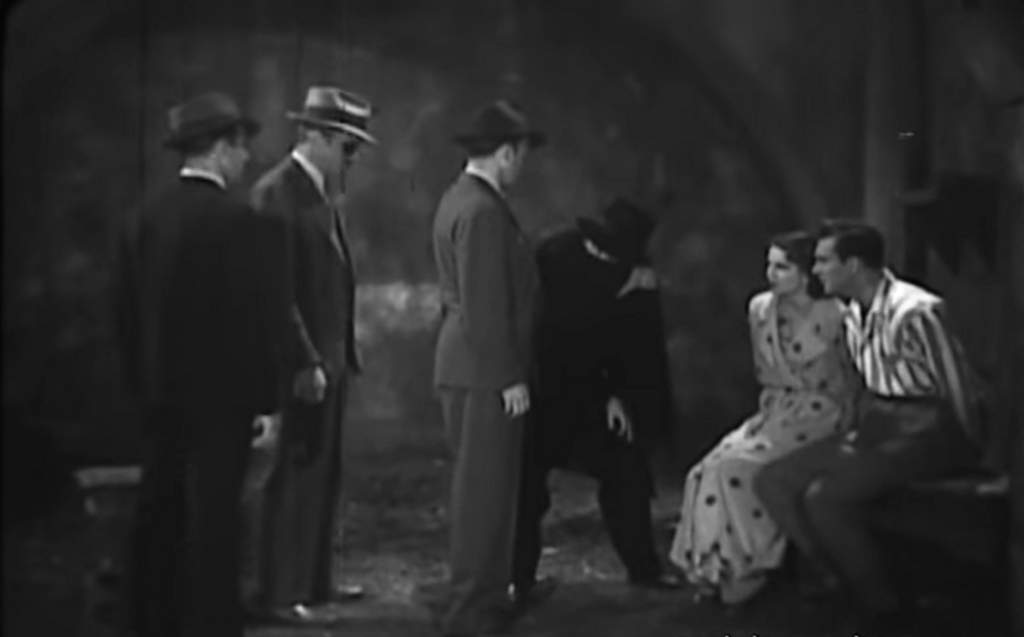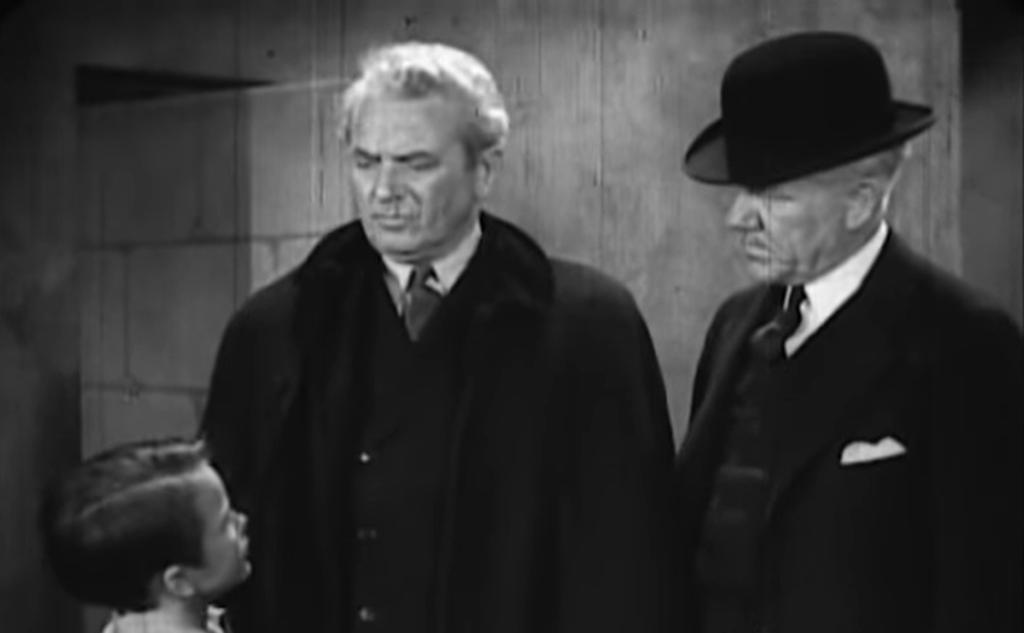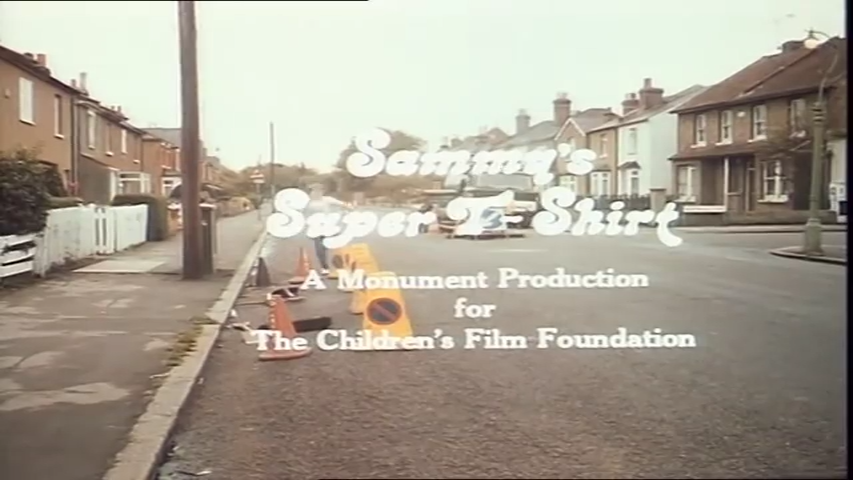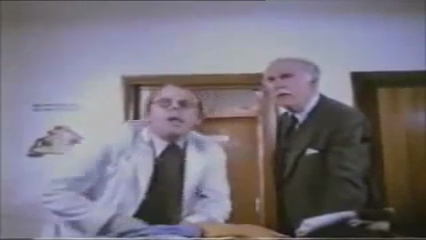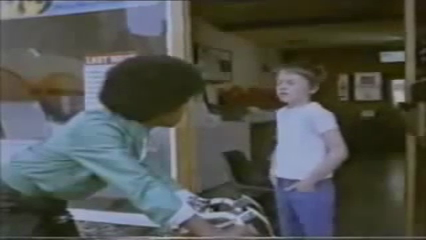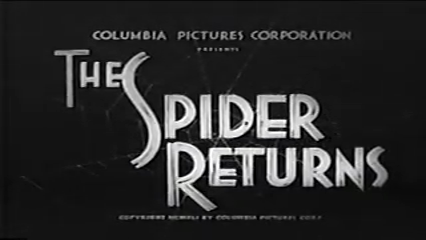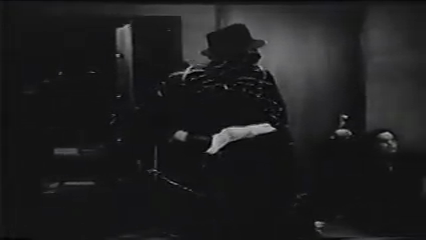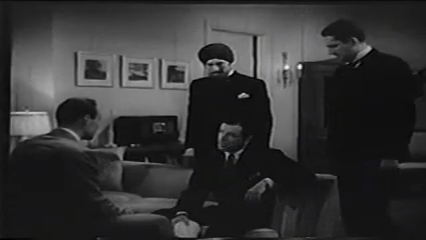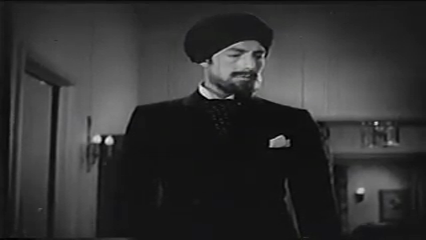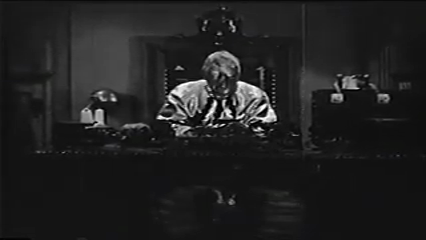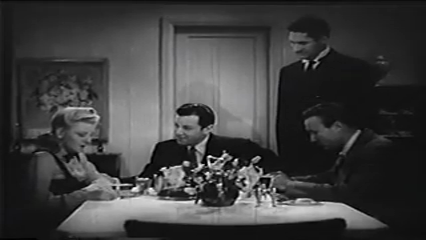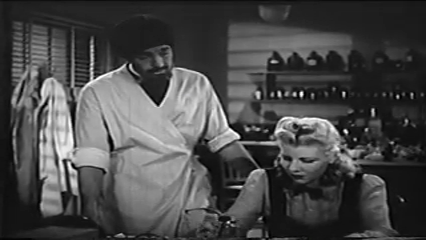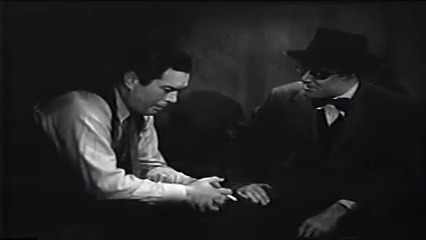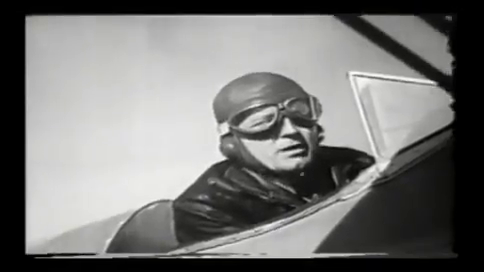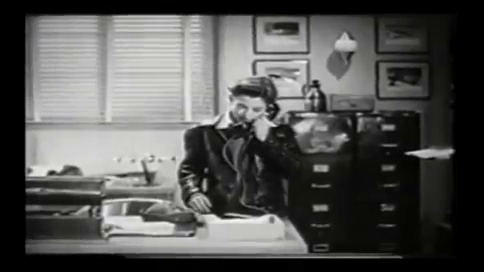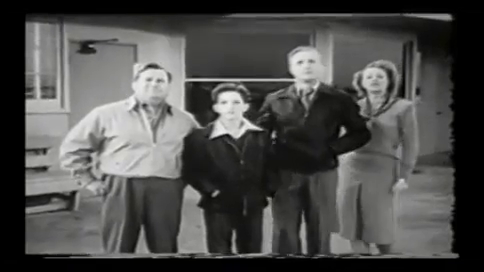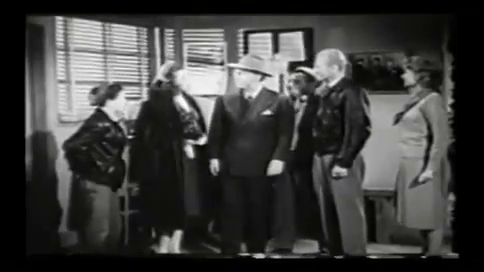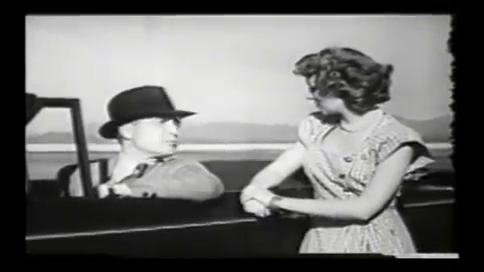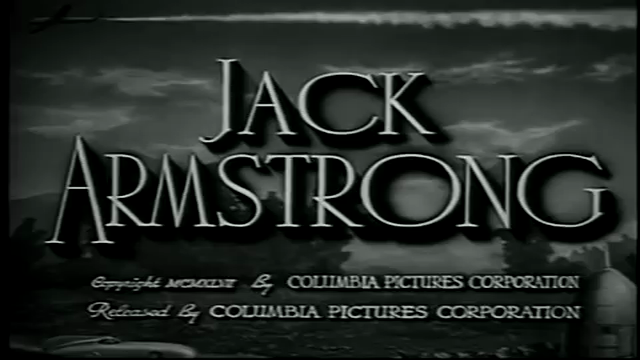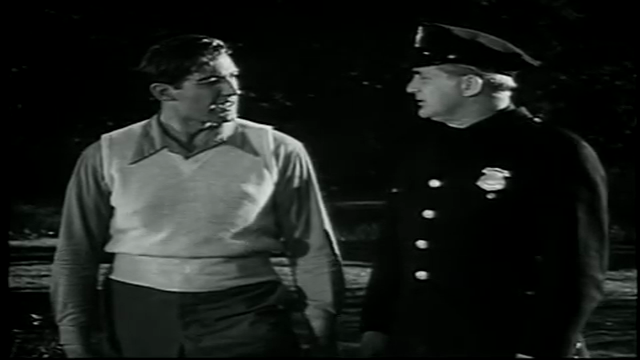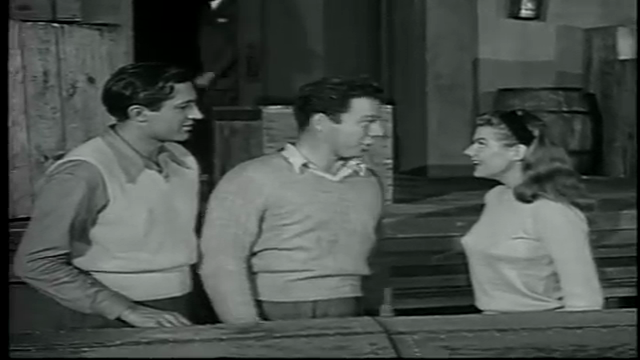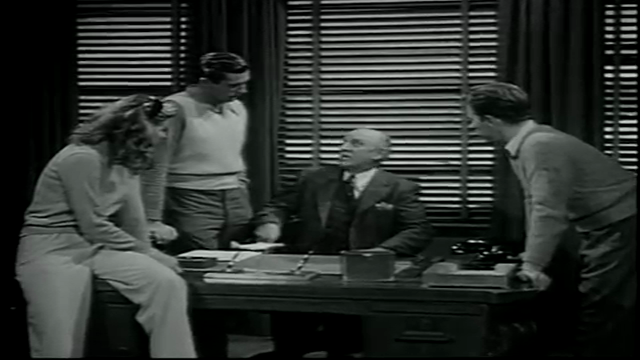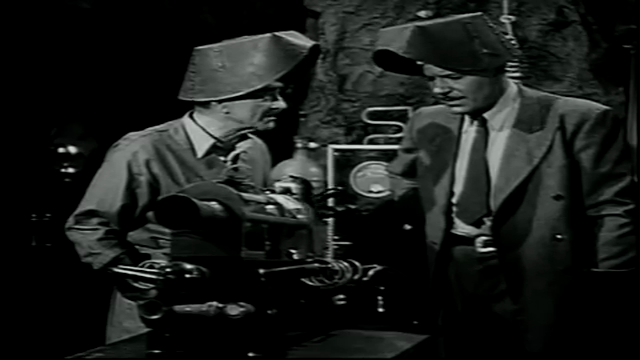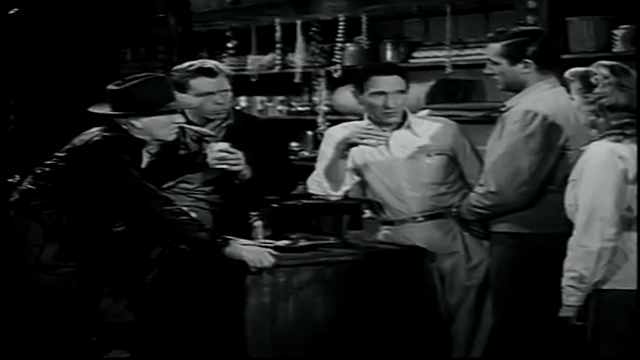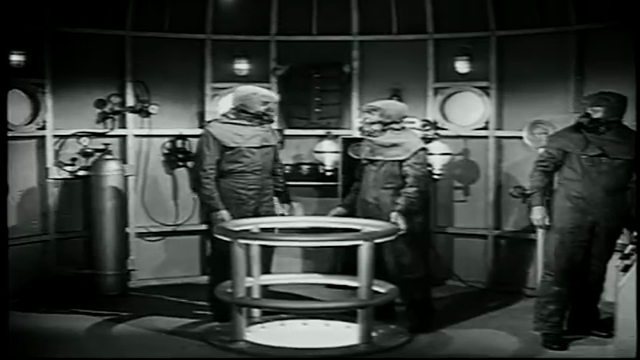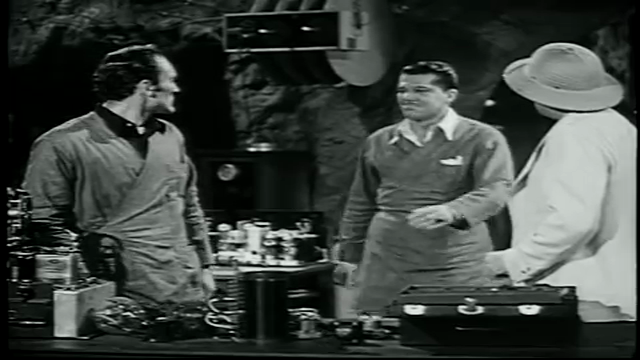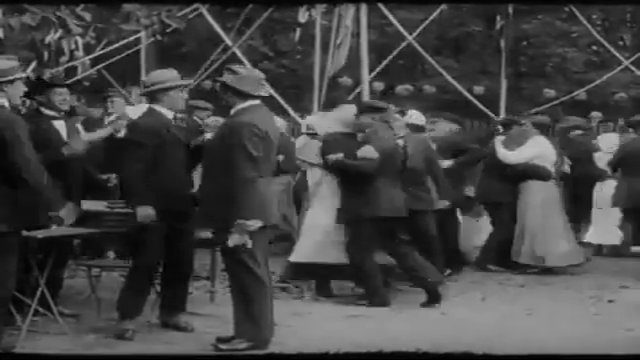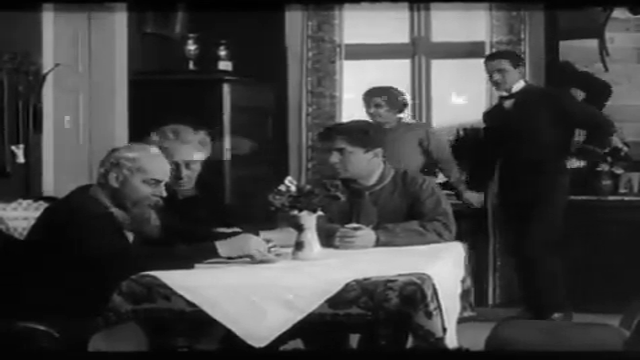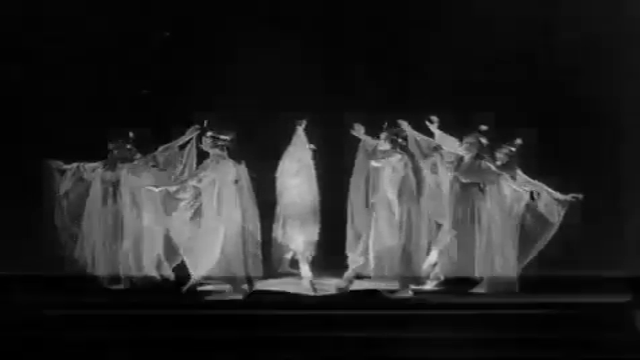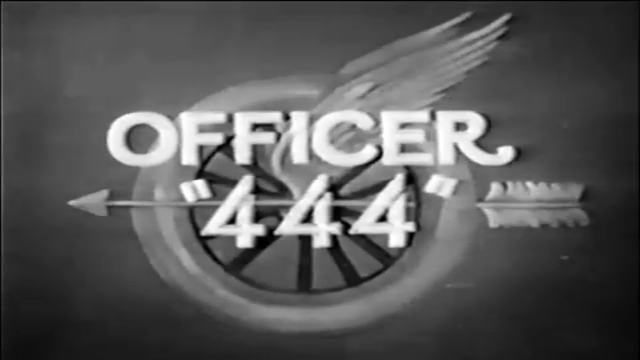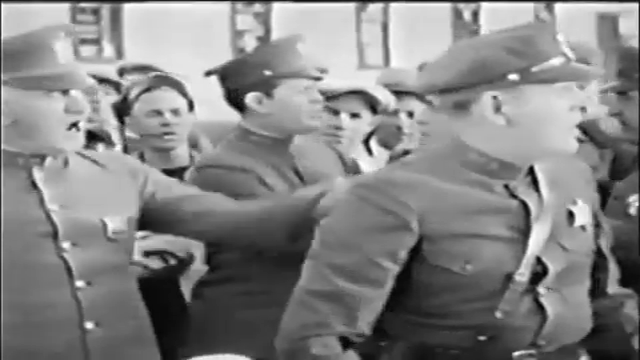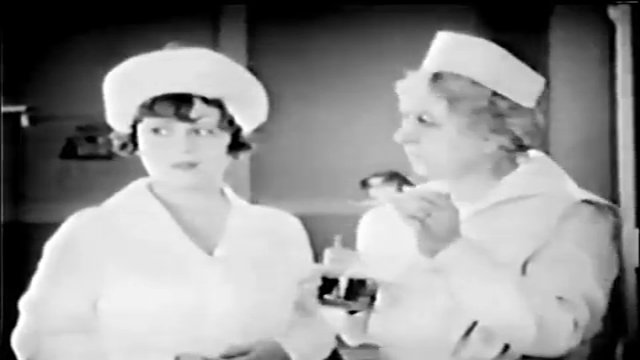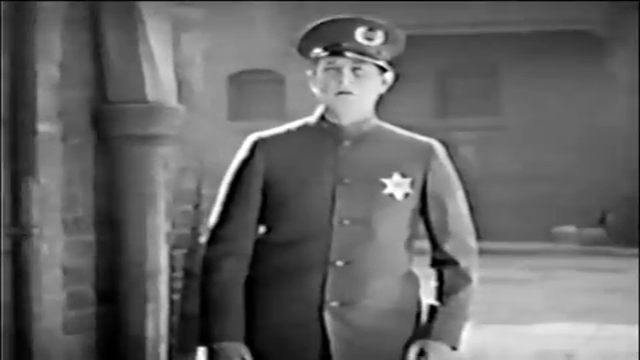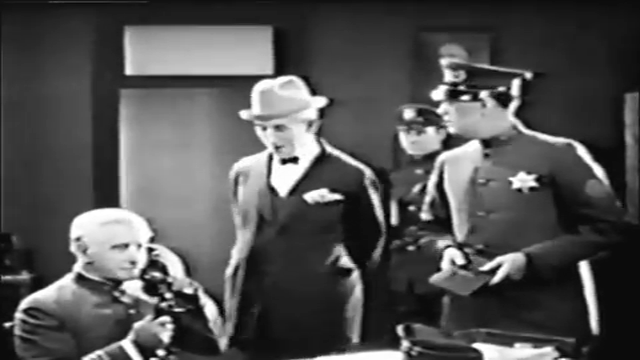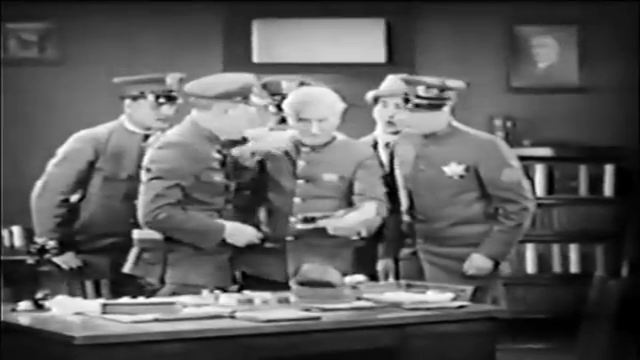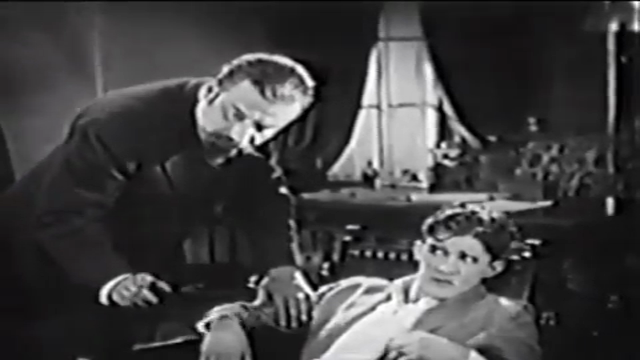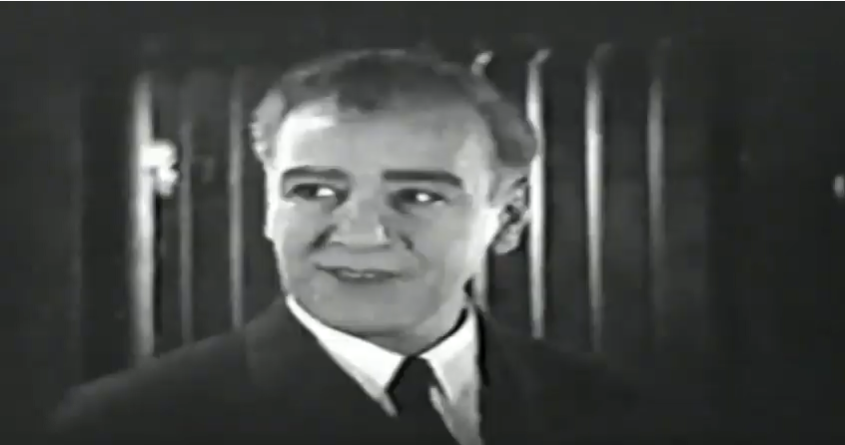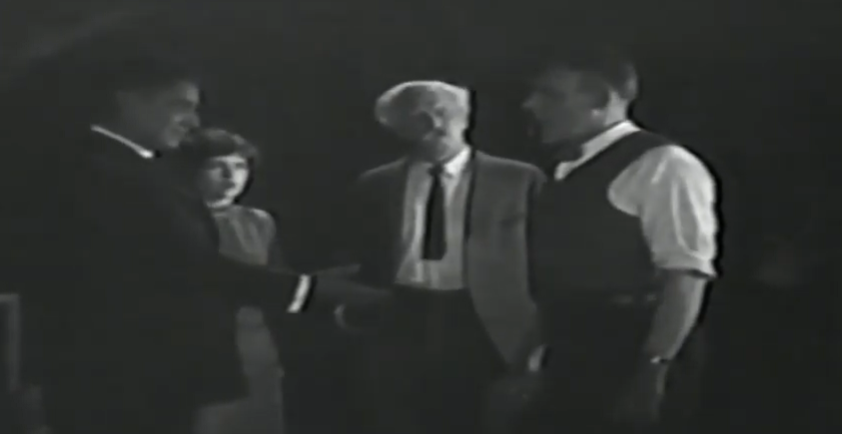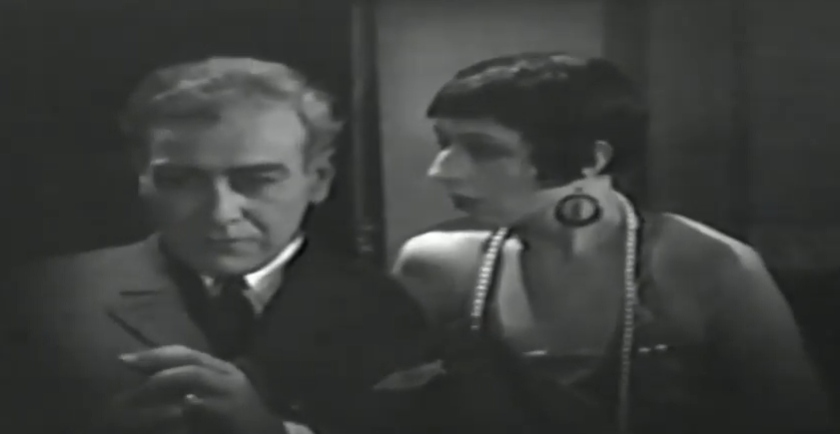-
#422 – Captain Midnight (1942)
Captain Midnight (1942)
Film review #422
Director: James W. Horne
SYNOPSIS: Professor Edwards has invented a new type of radar that will surely help the U.S. government in the war effort. However, a foreign power has employed criminal mastermind Ivan Shark to steal the device for their own use. Ace pilot Captain Allbright uses his secret identity of Captain Midnight to try to stop Shark and his men before the device falls into their hands, and to stop Shark’s bombing of American cities using his own aircraft…
THOUGHTS/ANALYSIS: Captain Midnight is a 1942 movie serial based on the radio plays of the same name. The plot is fairly straightforward and very familiar if you’ve ever seen a movie serial from this era: Ace pilot Captain Allbright uses his masked alter-ego Captain Midnight to stop a criminal from stealing a new weapon and selling it to an enemy government. It’s the same plot used through many wartime serials that would have had contemporary relevance. Unfortunately, there isn’t much content to separate it from the rest of similar serials, as there are plenty that use masked alter-ego’s, and also lots that centre around the use of planes. While using the characters from the popular radio play would have brought in extra viewers, there isn’t much uniqueness that viewers will get from the serial. The villain’s plots of stealing a new invention and bombing American cities are a bit interchangeable, and the serial moves back and forth without any real continuation or progression of the plot, resulting in very little development over the course of the fifteen chapters. Like every other serial, each chapter ends in a cliffhanger in which Captain Midnight faces certain doom only for it to be quickly resolved at the beginning of the next chapter. While these resolutions are usually anti-climactic, the serials produced by Columbia Pictures often have the least creative solutions, with Captain Midnight mostly just escaping car crashes or explosions by just walking from them a little dazed. In one such cliffhanger, he just walks away from a plane crash and jumps into a fistfight, which is quite ludicrous even by the serial’s standards.
Captain Allbright/Midnight is the typical serial hero: the square-jawed all-American hero who gets into plenty of fights and daredevil escapes. There doesn’t seem to be much point in his alter-ego: everyone seemingly knows who he is, and it wouldn’t matter if he was exposed or not. His “Secret Squadron” who aid him in his heroic deeds don’t really have a part to play, and what little we see of them shows they only fill very typical roles of sidekicks. Major Steele, Midnight’s government contact, is the authority figure who gives the orders and who Midnight plans with to catch the villains. The main villain himself, Ivan Shark, has a distinguishing trait in that he is a master of disguise, and subsequently disguises himself as a number of the serial’s characters over the course of the fifteen chapters; including Captain Midnight himself. His disguises also come with dubbed voice-overs of the characters he is playing, which is very obvious. It’s a trait that was used by the protagonist in The Spider serials, and definitely used to better effect there. Shark’s daughter Fury (that is her name apparently) has a role as second-in-command, but doesn’t really play much of a part. At the start of the serial, she seems reluctant to follow some of her Father’s schemes, leading me to believe she may be a character that swaps sides and questions her loyalties, but that is perhaps too complex for this serial, as this trait is soon forgotten and quickly becomes just another flat villain giving orders.
The main problem with Captain Midnight is that it’s story goes nowhere. There’s no build-up, and the focus keeps shifting so it feels like nothing of consequence is happening, which means it is going to be difficult to keep viewer’s attention over the course of fifteen chapters (or four and a half hours). Some of the stunts are decent, but nothing too outstanding, and there’s not enough plane-based scenes that you might expect from the titular character. The villain’s motivations are confused and all over the place, which further confounds any attempt to advance the plot. Although it doesn’t stray from the typical serial formula, there’s definitely better examples of the format you can watch.
-
#419 – Bill and Ted Face the Music (2020)
Bill and Ted Face the Music (2020)
Film review #419
Director: Dean Parisot
SYNOPSIS: Bill S. Preston esquire and Ted “Theodore” Logan were supposed to unite the world through their music. Nearly thirty years after they played a gig to the world, they are still yet to write the song that will they are destined to actually unite the world with. Now married with grown-up children, Bill and Ted are confronted with their failure by being told that reality will cease to exist unless they can write the song. Bill and Ted have the idea to travel into the future and take the song from themselves when they’ve written it, while their daughters Billie and Theo travel into the past to gather up some famous musicians to help them out. However, the Great Leader of the future has lost faith in the duo, and has sent a killer robot to track them down through time and kill them, believing that their deaths may be able to save reality…
THOUGHTS/ANALYSIS: Bill and Ted Face the Music is a 2020 sci-fi comedy film, and the third film in the series, after 1991′s Bill and Ted’s Bogus Journey. The film opens thirty years after the events of the previous film, with Bill and Ted playing the music for the wedding of Ted’s younger brother Deacon, and Missy who was Bill’s step-father in the first film, and Ted’s step-father in the second, which makes for a humourous scene that brings together a lot of the characters of the previous films, and shows what they have been up to in the twenty-five years since we saw them last. However, for Bill and Ted themselves, the last twenty-five years have not been so kind, as they have constantly failed to fulfil their destiny and write the song that will supposedly bring universal harmony and save reality. They are summoned to the future where they are asked to explain their actions, but their usual charm doesn’t seem to be working this time. They are forced to work on the song as the timer counts down to when they must perform it. They have the idea to instead travel to the future and take the song from themselves when they have written it, and so begins another ‘excellent adventure’ for the duo as they travel to various points in their future to find the song they supposedly have to write. After a thirty-year gap between films, there is undoubtedly a lot of expectations for someone who grew up watching these films for this new one to live up to the nostalgia of the first two. Thankfully, and perhaps even surprisingly, this film manages to capture the feel of the previous films, while also taking them somewhere new through the future and possible realities. At the heart of it though, is still this unshakeable friendship between two rock-loving guys which forms the basis for bringing out the very best in the entire universe. The film acknowledges its predecessors through both returning many of the characters, and also small little references which will make you laugh if you recognise them. The Bill and Ted films were never perfect or perfectly-polished masterpieces; they were just a fun adventure about two ordinary guys who have extraordinary adventures, and this film fits in perfectly to that. It didn’t have to be made, but it was made for the fans that have such a fond memory of the films, and through the return of the original writers and many of the characters, it’s hard to see how they could have made a better movie to round off the trilogy. Like I say, the previous films aren’t perfect and neither is this one, but again that nevertheless binds them together.
The main plot of the film is mostly split into two: firstly, you have Bill and Ted travelling to visit themselves in the future to find the song that they will supposedly write, and take it back to the present. In doing so, they come across many versions of themselves where they didn’t write the song, and their lives have fallen apart, including their wives leaving them. Bill and Ted, through this constant time-hopping, are brought into contact with the consequences of their actions, and try to avoid their bad futures by fixing the present. This again reflects the tireless wholesomeness of the duo as they recognise their mistakes and try to do everything they can to fix them. They are also being chased down by a robot from the future, sent by the Great Leader who believes that since Bill and Ted fled from the future and making the song, another interpretation of how to save reality would be to kill them, and so she sends the robot to do it. The series has never really needed villains: in the second film, the villain doesn’t really have much of a role to play himself, but rather just sets things in motion. The driving force of the films has always been about Bill and Ted learning something and improving themselves, rather than defeating an overarching villain, and again, this film does that too. The killer robot does have a small redemption arc as he is integrated into the cast, and it again shows how Bill and ted can win over just about anyone. The other main plot point concerns Bill and Ted’s daughters Billie and Thea, as they try and help their Dad’s out by travelling into the past and collecting famous musicians to help with performing the song. This element of the plot is a little weaker than the scenes focusing on Bill and Ted, and is quite similar to the first film. Nevertheless, there’s still plenty of laughs to be had, and Billie and Thea are genuinely likeable characters, in that they reflect their Father’s mannerisms and optimism, combined with being adults of the 21st century. More could have been done with their characters, but I think keeping focus on Bill and Ted themselves is the appropriate decision. Kelly, who is the daughter of Rufus, the duo’s mentor from the first two films, is also a fun character who doesn’t have the coolness of her father, but is still doing her best. Although she is not her Father (the actor who played him, George Carlin, passed away between the film), her belief in Bill and Ted reflects that constant returning theme of how a simple optimism, while not being afraid of confronting reality, can make a difference, even if you’re not as cool as Rufus.
As I mentioned, i have very little criticisms regarding the film, but there are definitely some things which stand out as being issues. While the majority of the film is well balanced and structured, the last part feels a bit rushed, with everyone getting together and a lot of references being used which leaves little time to appreciate them, and the magnitude of, for example, returning from the dead. Perhaps the main hindrance is the lack of budget: it is obvious that a lot of the scenes from the future etc. are done on greenscreen, and makes some of them feel a bit static and lifeless compared with the energy and often weirdness we got in the previous films. None of the films are very high budget, and that’s part of the charm in that the ordinariness of the leads juxtaposes against the bizarre situations they find themselves. The ending of the film had a revelation that was quite easy to spot ahead of time, and it accomplishes what you expect and want it to: it goes big for the big finale which saves reality, but again I feel like it needed just a little more spectacle than the budget could afford. Nevertheless, It is definitely satisfying, and does the story justice. One cool little feature is that the countdown to the time that Bill and Ted have to perform their song is exactly in synchronicity with the runtime, adding that little extra investment. The song itself that they perform is pretty much perfect: it combines a host of instruments that encapsulate the diversity of reality while having that distinct classic rock/metal sound that Bill and Ted is known for. The fact that it has no lyrics also reflects how the power of music transcends language. It sounds like the song I’ve been waiting thirty years to hear. The more I think about it, the more I appreciate it, and I think this just reinforces just how this film nailed exactly what Bill and Ted is about and how it did exactly what it needed to thirty years later.
Overall, Bill and Ted Face the Music is a worthy, and fully-formed addition to the beloved series: it doesn’t feel like a cash-in or a pointless add-on, but takes the characters people remember fondly and allows them to fulfil the potential they have been destined for for thirty years. It’s a love-letter to those people who grew up with the characters and have a nostalgia for them, and the film never feels like a disservice to that nostalgia, which in itself is a remarkable achievement if you look at other franchises which try to do the same thing. Even though the previous films explored all that could be explored through both the past and after-life, Face the Music still offers something new in the travels through the future and confronting their alternate selves, and the weight of their actions. Throughout it all, even when Bill and Ted are despondent in their lack of success in writing their world-changing song, their simple, but persevering optimism always sees them through the darkest of times. Alongside this, this optimism does not blind them to confronting the mistakes they have made, and are constantly trying to fix things (they continually “face the music” in more ways than one). Face the Music really captures the themes of the series, and brings them together in a satisfying way. It’s not a perfect film, but neither were it’s predecessors, which makes them fit together well. The film is visually hampered by it’s lack of budget and over-reliance on greenscreen, but those are really minor issues that don’t detract from the film’s story and message. For any fan of the previous films who remembers them fondly, Bill and Ted Face the Music is both a worthy tribute and a successful continuation of the story of two ordinary teenagers who have gone on to accomplish extraordinary things.
-
#417 – Blake of Scotland Yard (1937)
Blake of Scotland Yard (1937)
Film review #417
Director: Robert F. Hill
SYNOPSIS: Sir James Blake is unveiling a new invention to the League of Nations which will ensure world peace, however, the presentation is interrupted by a criminal mastermind known only as “The Scorpion,” who wishes to steal the invention for his own nefarious uses. Jerry Sheehan, an American who has helped create the invention along with Blake’s niece Hope, works with Blake, Hope and their friends to find the invention and uncover The Scorpion’s true identity.
THOUGHTS/ANALYSIS: Blake of Scotland Yard is a 1937 movie serial composed of fifteen chapters released by Victory Pictures. Interestingly enough, a serial of the same name was released ten years prior by Universal Pictures, directed by the same director as this one. It is unfortunately a lost serial and no footage seemingly exists, but from what I can tell, it was quite different from this one, and none of the characters are the same, meaning that this serial is just capitalising on the name of it’s predecessor and it’s sequel, which is quite an odd move considering that ten years is a large gap in a time when there would have been no way to re-watch these serials unless they were re-run in theatres. maybe they bet on adults recognising the name and taking their kids to go see it. Anyway, the serial starts off with Sir James Blake, a retired inspector at Scotland Yard, unveiling an invention he has made along with his niece Hope and their friend Jerry. They are presenting it to the representatives of the league of Nations as a device that can target and destroy battleships from over one hundred miles away. They plan to donate it to the League of Nations to ensure world peace; which is an interesting way of creating peace by giving countries the unlimited capacity to blow each other up. What do they call this miraculous device? a “death ray.” Yes, the architect of peace named the death ray, will surely stop all wars. Nevertheless, the demonstration is interrupted as a criminal mastermind known as “The Scorpion” shows up with his goons and steals the device, hoping to sell it to a foreign power. This sets up the typical serial premise of the heroes foiling the criminal’s various schemes while attempting to unmask him, and for the most part it really falls into the standard serial format without exception.
I suppose what makes the serial unique is that it is set in England, which is different from the usual serials set in unnamed U.S. cities. The trouble is that it is obviously made in the U.S. with American actors, and none of them really make an effort to use an English accent. It sometimes sound likes they’re trying to put on an accent, but it definitely doesn’t sound English. The only character who has an excuse is Ralph Byrd’s character Jerry, who is meant to be American, and who also seems to try and sound a little English. This is Byrd’s first serial appearance, from which he would go on to star in S.O.S. Coast Guard and Dick Tracy in the same year, eventually setting him up to play Tracy in various serials, feature films and TV shows until his death in 1954. One of the running jokes (if you can call it a joke) is that Hope’s kid brother Bobby occasionally uses American slang and phrases, which he or Jerry have to explain to the rest. In one scene, Jerry jokingly chastises Bobby about needing to speak “proper English,” which is completely bizarre considering Jerry is the American, and everybody else also doesn’t seem to speak “proper” English. Bobby is also probably the only character who makes a more significant effort to speak an English accent. Despite the title, there’s not really much in the way of police or detective work, and we only see Scotland Yard itself in one scene. As mentioned, it seems the serial is relying on the name for recognition only. The Scorpion as the villain always walks around with a hunched back, and always covers his face with a claw on his hand (he also wears a mask as well, but we never really see it because of the aforementioned claw). Why the claw? To fit with the “Scorpion” name I guess? Why is he always covering his face with
The action is split between a number of locations which adds a small amount of variety. Most of the action is set in Blake’s stately home, which has a number of secret passageways, underground tunnels and spy-holes for all sorts of tricks to play out. There is also the gang’s hideout in London, where we see stock footage of the London skyline and a street scene which I guess looks London-esque. They could have definitely utilised it more though to give the serial a unique setting. There’s also a good chunk of the serial that takes place in Paris, specifically a café and a hotel. These scenes often feel completely pointless, consisting of some odd dancing by a couple who hate each other, who are also spies…or something like that? it’s really difficult to follow, and frankly very boring. There’s no real sense of it being in Paris either, apart from one guy wears a stripy shirt and another woman a beret in typical style.I think they’re also trying to put on French accents, which is about as successful as the attempts to do English ones. There’s a lot about this serial which just pads out the time, and offers very little to the story (of which there is little anyway). A seventy-minute feature film version was released along with the five-hour serial, which I assume was able to cut out almost all of these pointless scenes, and shows just how much of the serial was inconsequential.
Despite the variety of locations, the sets feel very empty and dull, with no real character to them. There’s not really much action as in other serials, as most of the chapters revolve around following henchmen, or devising a trap to capture a henchman. While most serials throw in a fistfight and vehicle chase almost every chapter, this one doesn’t, and unfortunately doesn’t offer anything interesting to replace it. The identity of The Scorpion when it is revealed is a surprise, but doesn’t really have any ramifications. One of the most distracting things about the serial is the lack of background music. It makes whole scenes completely lifeless, especially the fight scenes, which lack any sort of energy. Overall, as you can probably guess, Blake of Scotland Yard is not a very good serial. Considering we were getting serials like Flash Gordon at around the same time, there’s no way a barebones serial like this could offer anything exciting. The plot is very typical of the serial format, but manages to make it needlessly complicated and difficult to follow across all the locations and the spying, doppelgangers and betrayals that obfuscate the flow of the story. The setting in an English stately home is novel, but undone by sparse sets and lack of appropriate accents. Byrd as the lead gives a charismatic and charming performance, but the rest of the cast are dull and without merit, and Byrd shines much more in his role as Dick Tracy. Give this one a miss, you are not missing much.
-
#413 – Sammy’s Super T-Shirt (1978)
Sammy’s Super T-Shirt (1978)
Film review #413
Director: Jeffrey Summers
SYNOPSIS: Young Sammy Smith is training hard to enter a local race. After he enters, a pair of bullies throw his lucky shirt up into the window of a factory. Sammy and his friend Marv sneak in to get it back, unsuspecting that the factory is a top secret laboratory, where Sammy’s shirt has been subjected to an experiment that has made it indestructible, and gives Sammy extraordinary strength when he wears it. The owner of the laboratory and his scientist find that Sammy has the shirt, and give chase before he can reveal the shirt’s secret…
THOUGHTS/ANALYSIS: Sammy’s Super T-Shirt is a 1978 British children’s film. At the start, we see twelve year old Sammy Smith exercising in his room trying to get stronger so he can compete in the local race. He goes to sign up for the race with his friend (and self-proclaimed manager) Marv, where the two are accosted by two bullies, who steal Sammy’s lucky T-shirt and throw it through an open window. It just so happens that the building the shirt lands in is a top secret laboratory where experiments on making an indestructible material are being carried out, and it also happens that Sammy’s shirt is used for the experiment that is successful. The lab’s owner, Mr. Becket and the scientist, Mr. Trotter, want to keep it a secret and exploit their discovery, but after Sammy and Marv sneak in to get the T-shirt back, they must find a way to get it back before the young boy ruins their discovery. The plot of the film is a very simple one, which mainly involves Sammy and Marv being chased by the two adults, and the various tricks they use. Not too much to say about it, but it’s easy enough to follow, and provides a few humourous moments through it’s slapstick comedy. Being only just under an hour long, everything is neatly wrapped up and there’s no real lull in activity, so it will keep it’s younger target audience entertained.
There’s something very nostalgic about this film: all of the locations are straight from their time. There’s no fancy sets or designs, just real locations that are a snapshot of the time. I imagine this would have been great for a young kid of the time, as these locations would have been just like the working-class streets they were growing up and played in, meaning their imaginations could run wild with the idea of running through their neighbourhoods with super powers. The child actors are also fairly good, and it would be easy to identify with young Sammy. His friend Marv being black and having a prominent role is something less than ordinary, as you certainly didn’t see many young black actors in these types of films, much less as just as much of an ordinary kid as the white lead. They do remark once how unusual their being seen together is (”one black and one white”), but other than that it just feels like two kids being kids without stereotypes, which is pretty cool.
While kids of the time of it’s release would have probably enjoyed the down-to-earth nature of the film, it is definitely dated today, and kids that may watch it now certainly wouldn’t get the same mileage out of it’s setting. Setups such as Sammy taking the clothing to the launderette to be washed just wouldn’t resonate, alongside the housing and manners of speech just wouldn’t reflect what we would recognise as “ordinary” today. Nevertheless, Sammy’s Super T-Shirt is a bit of short, harmless fun without too much merit. It feels like a time capsule of decades gone by, and if you grew up around this time, you would certainly get a wave of nostalgia through the locations and language used by the ordinary, working-class cast of the late seventies. Kids today won’t get anything out of it, but an interesting snapshot of times gone by.
-
#412 – The Spider Returns (1941)
The Spider Returns (1941)
Film review #412
Director: James W. Horne
SYNOPSIS: A masked criminal, known only as The Gargoyle, and backed by malicious foreign powers, aims to sabotage national defence production by targeting the owners of key industries. Criminologist Richard Wentworth must once again don the secret disguise of “The Spider,” a masked vigilante, in order to move outside of the rules and regulations of law enforcement, and along with his friends stop The Gargoyle before he can do irreparable damage to the country…
THOUGHTS/ANALYSIS: The Spider Returns is a 1941 movie serial and the sequel to the 1938 serial The Spider’s Web, based on the magazine comics of “The Spider.” The serial follows a similar setup to the first one, with criminologist Richard Wentworth secretly disguises himself as the masked vigilante The Spider in order to stop another masked individual known only as The Gargoyle, whose criminal gang is working to sabotage industries related to national defence. Sabotage really is the key word for the plot of this serial: it was released in 1941 in the context of the second world war and a heavy focus on the U.S. gearing up for getting fully involved. The concept of sabotage runs through a lot of wartime serials, with suspicion being placed on “the enemy within,” who would attack not from outside, but from the inside through the acts of sabotage. There’s a fair amount of wartime messaging throughout the serial, explaining how “our great country” is under threat from “foreign powers,” who will target key industries. No specific country names are mentioned, but you can figure it out. With this theme, the serial has a bit more of a darker tone to the story, but never anything overly scary, as these serials are generally aimed at younger audiences and bringing in families. To seemingly offset the darker tone, there’s some more silly moments, usually between The Gargoyle and his inventor assistant, as The Gargoyle berates him for his inventions going wrong. They do however make The Gargoyle feel a bit less threatening, but again that may have been the purpose to make the serial a bit more family-friendly, and the villain less scary, while still getting the wartime message through. Overall though, it does present a bit of a mismatch that makes the comedy seem on the whole out of place.
All of the protagonists from the first serial make a return here, although only two of the original actors reprise their roles: Warren Hull as Richard Wentworth AKA The Spider, and Kenne Duncan as Wentworth’s chauffeur Ram Singh. Dave O’Brien, who was Hull’s stunt double in the first serial, now takes over as Jackson, Wentworth’s assistant. The characters more or less have the same roles as they did before, but perhaps have less to do than they did in the first serial, which balanced out the use of the characters a lot more than most serials. Hull performs the triple role of Wentworth, The Spider, and Wentworth’s disguise Blinky McQuaid, a petty criminal who Wentworth disguises himself as in order to go undercover and get information from The Gargoyle’s henchman, and his multi-faceted role is very much the centrepiece of the story. The different roles give enough variety to the situations, and causes Wentworth to consider his actions in terms of how each character is perceived, such as police commissioner Kirk’s attempts to catch The Spider, and who always has suspicions that Wentworth is the masked vigilante. As mentioned, the villains are a bit less threatening in their hapless endeavours, as The Gargoyle gets into some comedic banter with his inventor assistant, and using his X-Ray eye machine, spies on his underlings to see they are having a party instead of doing his evil work.
While The Spider’s Web was a wildly popular serial that probably (in part) sparked the trend of masked superhero serials, The Spider Returns isn’t quite as good as its predecessor, but is still a decent example of the format, with enough variety through Hull’s triple performance, the sci-fi inventions used by the villain, and the focus on sabotage and its wartime message has some impact. The trend of masked superheroes faded away after the war was over, instead making the leads more military-like and ordinary to reflect the victorious soldiers of the war. However I think the escapades of The Spider shouldn’t be forgotten, as they were very influential in the production of the serial format in its time.
-
#410 – Hop Harrigan (1946)
Hop Harrigan (1946)
Film review #410
Director: Derwin Abrahams
SYNOPSIS: Hop Harrigan, a pilot along with his buddy “Tank” Tinker, are hired to escort a scientist to his secret laboratory hidden in the mountains, where he is working on a powerful new source of energy. Meanwhile, a man known only as the “Chief Pilot” is after the invention for himself to use as a deadly weapon. Hop and his friends are caught up in the schemes of all of these players, and they must stop them before disaster befalls the world…
THOUGHTS/ANALYSIS: Hop Harrigan is a 1947 movie serial based on the Hop Harrigan character from the All-American Comics series, as well as the radio plays. Harrigan became quite popular during the course of the second World War, probably due to his heroic piloting antics which would have resonated with the population. However, his population waned after the war ended along with many of the similar characters, with people rather turning their attention to costumed superheroes and the villains being spies rather than soldiers. The serial starts off with Hop performing a mid-air rescue, then returning back to the airfield where he works. he is offered a job by a man named Arnold to fly a scientist named Dr. Tobor to his secret laboratory. Tobor has been working on an invention that runs on a powerful new energy, and has to keep Hop and Tank blindfolded while in the air so they do not see where the lab is. Meanwhile, an unknown person calling himself “The Chief Pilot” is intent on getting a hold of Tobor’s invention for himself, and sends his goons to kidnap him. The plot of the serial as always follows the standard format of each chapter having a different scheme or plot to foil, with it ending on a cliffhanger for the next chapter. I imagine the serial format isn’t the best one to adapt Hop Harrigan in, as he is probably more used to dealing with soldiers and villains rather than engaging in thwarting espionage, but again that’s like a lot of the serials, which used the name of a comic book character and didn’t really adapt anything else about them.
On the heroes side, you have the standard All-American heroics of Hop Harrigan, his sidekick and comic relief “Tank”, who offers some decent interactions with his goofiness playing off against other characters. Gail is the token female character who runs the airfield (though she doesn’t really do much), and her younger brother Jackie, whose book-smarts often clash with Tank’s brute-force approach. Jackie provides a good example of a younger characters which the kids in the audience can relate too, and he has a decent amount to do, which helps in that regard. Other than that though, the heroes are pretty unremarkable. There are quite a few villains in this serial, ranging from the mysterious Chief Pilot, whose identity isn’t revealed until the end (a typical serial trope), and an array of henchman, some of whom are working with the Chief Pilot, and some who are working for Hop’s employer Arnold and secretly working against him. There’s also Dr. Tobor (’Robot’ spelled backwards in case you hadn’t noticed; I’m pretty sure I’ve watched another serial or film which uses the same name, but I can’t remember which), who essentially plays the eccentric scientist who becomes more and more erratic as the serial progresses. He is sought by both heroes and villains, and constantly tricks them and plays them for fools, which shakes up the dynamic. Tobor as the wildcard element helps to give a bit of an original edge to the story, and that is welcome.
If you’re going to watch a Hop Harrigan serial, then no doubt you’ll be expecting plenty of scenes in the sky and plane fights. The serial more or less delivers what it promises with plenty of scenes taking place in the air, and shot reasonably well for the time, but most of the action does take place on the ground, and the plane scenes are just to travel from place to place, or to follow a car from the air.
-
#408 – Jack Armstrong (1947)
Jack Armstrong (1947)
Film review #408
Director: Wallace Fox
SYNOPSIS: When a valuable shipment and scientist Vic Hardy are kidnapped, young Jack Armstrong along with his friend Billie, his Sister Betty, and their Uncle Jim Fairfield, all attempt to find and rescue him. They eventually track him to an island in the Pacific, where an evil scientist has hidden Hardy away in a secret laboratory where he is building a weapon that could enslave the world. Jack and his friends must deal with the native islanders and the scientist’s henchman before the weapon is completed and the world is at their mercy…
THOUGHTS/ANALYSIS: Jack Armstrong is a 1947 movie serial based on the radio play of the same name.The serial opens up with young Jack Armstrong and his friend Billie along with his sister Bettie working on a car at the Fairfield aviation company, which Billie and Bettie’s Uncle Jim owns. Almost as soon as the serial starts, a hit and run takes place outside the Fairfield office, so Jack and Billie jump in their car and give chase. This car of theirs is a huge beast that just looks like a big steel box put over a normal car. Nevertheless, it gives the opportunity for the serial to open on an action-based note, and to entice viewers to stay and come back for the rest of the serial’s chapters. After Jack and Billie catch the driver, their car is never seen or mentioned again, which is a bit naughty opening with it and thus giving the impression you will see more of it in the next chapters.
One of Jim’s employees, Hardy, is monitoring some strange signals in the ionosphere. One of Jim’s customers named Pearce overhears this, who is working for the gang making those signals for some evil scheme, and has Hardy kidnapped so he can be forced to help with their plan. Jack and the gang track Hardy down to an island in the Pacific Ocean, which they travel to, but their plane is shot down on approach. The rest of the serial takes place on the island, where they meet the owner of a trading outpost named Grood, who is secretly the mastermind of the evil scheme to rule the world through building a weapon and deploying it in the atmosphere. The story involves Jack and the gang dealing with Grood’s henchman, as well as the native tribes that inhabit the island, and later on Pearce when he shows up on the island still pretending to be our heroes friends.
-
#407 – The End of the World (1916)
The End of the World (1916)
Film review #407
Director: August Blom
SYNOPSIS: When it is discovered that a comet is due to pass by Earth, panic and uncertainty over whether the comet will actually strike the planet. Stoll, a stock broker, sees an opportunity to make some easy money preying on people’s fears, but when the danger becomes too real, he and his wife must return to the small mining town which she fled in order to marry Stoll…
THOUGHTS/ANALYSIS: The End of the World (Verdens Undergang, also sometimes titled The Flaming Sword) is a 1916 Danish science-fiction film. The film starts off with the inhabitants of a small mining town visited by the mine’s owner, Stoll. When Stoll meets Dina, the daughter of the mine foreman at a dance, he suggests that she run away with him back to the city. Following a chastising from her Father about being a “harlot” for staying out late on her own (such as it was in 1916 I guess), Dina decides to run away with Stoll, leaving behind her Sister, Father and her friend Flint, who had hopes of marrying her himself. Fast forward a few years and we see that Stoll is a successful financier whose stock market dealings have left him very rich, and his now wife Dina has everything she could ideally want. The beginning of the film really takes some time to establish the characters and their relations. Stoll is the focal point of much of the film, and while he is marked as the villain throughout much of what is going on, he is still portrayed as having some humanity in his faithfulness and dedication to his wife. Ultimately, his manipulation of the stock market and his treatment of the mine’s workers leave him as very much an enemy to many of the other characters. Being perhaps one of the first disaster movies ever, it does the job of portraying how the end of the world impacts a number of different people from different walks of life.
When Professor Wisemann sees a new comet through his telescope coming towards Earth, the discovery generates a lot of uncertainty and panic across the world, as no one seems to know if the comet will hit the Earth or not. Stoll learns from his brother that the comet will probably hit the Earth in northwest Europe and cause significant devastation, and devises a scheme to buy a large number of stocks while there is panic, and have his friend at a newspaper print the (false headline) that the comet will not hit, leading Stoll to sell his stocks at a higher price and become even more wealthy. Even when Stoll learns of the comet’s impact, he insists the newspaper print the misleading story that it will pass by Earth so he can fulfil his scheme. Again, Stoll is made out to be the villain because profiteering over the end of the world is hardly going to go down well is it? Meanwhile, events in the mining town are moving along as Dina’s sister says farewell to her sweetheart Reymers, who has just graduated as a sailor and is leaving on board a ship.
In the third act, with the comet looming ever closer to Earth, Stoll realises the only place he can take shelter is the mine in the town where he met Dina: however, the populace are less than happy at Stoll over the way he has treated their town, and when they learn he is coming to town, Flint organises an attack on Stoll. Dina is also reluctant to return to the town, but is finally convinced. As the comet gets closer, Stoll organises a party for the end of the world, while the workers decide they are going to storm the party, setting the conflict for the final part of the film. As the comet enters the atmosphere, fragments start to rain down over the town causing mass destruction. The special effects are quite remarkable for their time, even if they’re typically just sparks flying over model buildings. Also the image of a comet overlaid into the sky of some scenes gives a feeling of impending doom. The film enjoyed a fair amount of success when it was released; in part capitalising on the fear and uncertainty surrounding Halley’s comet passing Earth a few years before, and the ongoing war in Europe which alerted people to a level of destruction they had never considered before. The film’s showing of mass destruction from meteors, houses being shaken and destroyed, and huge tidal waves gives a fair variety to the devastation and gives the feeling that nowhere is safe in these situations.
The film ends with most of the characters dying: Stoll and his wife are killed in the mine they are hiding in, Flint chases them, but the release of deadly gas kills him too. Dina’s Father passes away, and at the end we see Edith, Dina’s sister alone as she has miraculously survived. She goes up to the top of the church and rings the bell in the hope of alerting other survivors. Coincidentally, it turns out Reymers has managed to return to shore from the ship he was on, and on hearing the bell, the two are reunited to end the film on a somewhat happy note, that even through all the destruction, a sliver of hope has survived. Overall, The End of the World is a well-written spectacle that offers effects and a speculative scenario that film-goers would probably have not seen before. It’s relevance to the time is clear in regards to the amount of destruction the world was experiencing through war. The film does a good job of establishing a variety of characters and connecting them to each other, as we see how the disaster will affect people of different class and occupation, which has become one of the foundations for disaster movies. The spectacle would have engrossed movie-goers of the time, but there’s enough substance in the characters to appreciate the story underneath the spectacle too.
-
#406 – Officer 444 (1926)
Officer 444 (1926)
Film review #406
Director: Francis Ford
SYNOPSIS: When a new miracle chemical called “Haverlyite” is discovered by Professor Haverly, he intends it for the good of humanity. When he is killed by the criminal known only as “The Frog,” who wants the chemical for his own evil ends, Officer 444 of the flying squadron must stop The Frog and find Haverly’s son: the only other person who knows the secret formula for Haverlyite…
THOUGHTS/ANALYSIS: Officer 444 is a 1925 silent movie serial comprised of ten chapters. In the opening chapter, we see a building on fire, as the police and firefighters rush to get the situation under control. Officer 444, a member of the flying squadron revered by the community, heads into the burning building to rescue people trapped inside, and also to apprehend some dangerous criminals within. As is typical with these serials, the first chapter opens up with an ambitious scene involving lots of people and action in order to entice people in to coming back to the theatre for succeeding chapters, and doesn’t particularly tie in to the rest of the story. The plot itself centres around the discovery of a miracle chemical called Haverlyite, named after its discoverer Professor Haverly. The criminal known only as “The Frog” wants the formula for his own purposes, but when Haverly is killed, the secret formula dies with him…until that is, Haverly’s son appears on the scene. However he has lost his memory of the formula following his attempted abduction and his Father’s death, and so Officer 444 and The Frog do battle over young Haverly as Officer 44 tries to chase him down through the various chapters. The plot is easy enough to follow, and while nothing too special, is kept entertaining with a balance of action and investigation. The miracle formula of Haverlyite is left rather vague as to its applications: it has the power to heal people, but also to be a weapon of some form that The Frog wants to use to take over the world. The vagueness is, I think, part of the message of the film that any scientific discovery may be used for either good or evil, as evidenced by the foreword at the beginning of each chapter.
The cast of characters is fairly large, and adds some variety to proceedings: Officer 444 is the typical lead, and nurse Gloria Grey provides the typical female role, although I suppose it is a bit more involved than the glorified secretarial role most female roles have in these serials, as her nursing profession gives her purpose in scenes such as where she is working to restore young Haverly’s memories. Patrick Casey is Officer 444′s sidekick in the police force, and helps out with the more physical scenes. As you might be able to tell from the name, he fits the stereotypical Irish policeman role, but it will be a long time before cinema moved away from stereotypes. The Frog is presented as a clever criminal who disguises himself as a disfigured man. He sends a woman known only as “The Vulture” to stop 444 and interrupt his plans. While it is rare to find a second woman in a serial such as this, she does fit the role of an ambitious or clever woman that is always on the side of the villains, a role also seen in The Power God released a year earlier with the main villain’s wife. One of the more noteworthy characters is the chief of police played by August Vollmer, who was an actual police chief and one of the most influential in defining policing in the U.S. for better or worse. Dr. Blakely is a mysterious doctor whose purpose and identity provide an ongoing mystery that is only resolved in the final scenes, again providing incentive to get viewers coming back each week.
The serial does a good job of balancing the action and investigation scenes. There’s plenty of car chases filmed ambitiously, and some daring stunts such as a train switching tracks at the last second to avoid Officer 444. The fist fights aren’t as well executed, but it wasn’t until a few years later that fight choreography seemed to be more considered on film. Of particular note on the investigative side is the use of a polygraph or lie detector machine (called a “lieing machine” in the serial). This would have been a fairly recent invention and is probably the first time the device was featured on film. I wonder if Vollmer’s involvement allowed them to get their hands on one, since he would have been using them in his own police force at the time I suppose…
Overall, Officer 444 is a fairly standard serial, but at the time it garnered quite a lot of popularity from what I can tell. It’s story is easy enough to follow, but has a decent sized and varied cast who play a clear role in events. The action scenes showcase car chases and fights that are imaginatively and dramatically shot to emphasise the heroics of the heroes, and there’s enough mystery surrounding certain characters to keep viewers coming back. It’s not too noteworthy from a historical perspective, but it gives a somewhat interesting look at policing in the 1920′s if that interests you.
-
#404 – The Power God (1925)
The Power God (1925)
Film review #404
Directors: Francis Ford, Ben F. Wilson
SYNOPSIS: Professor Sturgess, with his assistant Jim Thorpe, has invented a machine that can draw infinite power from the air, which will be sure to revolutionise the way energy is produced. However, this invention has drawn the attention of the coal and oil companies, who have agreed that the invention is a threat to their monopolies, and must be destroyed. They hire career criminal Weston Dore to deal with Sturgess, but Dore has other plans to steal the invention for himself and become the new “power God”…
THOUGHTS/ANALYSIS: The Power God is a 1925 movie serial comprised of fifteen chapters, and one of the few serials that has sadly survived from that time. The story opens up with Professor Sturgess and his assistant Jim Thorpe finishing development on a machine described as “the marvel of the radio-electric age,” which can draw power directly from the air, providing a nearly infinite source of energy. This machine has drawn unwanted attention from the traditional energy businesses, who fear the collapse of their industry, hire criminal Weston Dore to get a hold of the machine by any means necessary. When Dore tries to buy the machine from Sturgess with the aim of suppressing it, Sturgess refuses. Dore then has to change plan and has Sturgess killed. With enemies closing in, Thorpe and Strugess’ daughter Aileen have to hide the machine and protect the invention from falling into Dore’s hands, who decides to try and keep the invention for himself to become the new “power God” of the modern world. The story has a familiar setup as with most serials, but this is one of the serials that defined the format for twenty years, and provided a ready-made template for companies like Republic and Universal to pump out similar serials in around a month or so.
At the time it was released, The Power God would have been something many people had not seen before, particularly in the science-fiction genre. Compared to those other serials, The Power God is a strong example of the potential of the format’s storytelling potential. Following Jim asking Professor Sturgess’ approval to marry Aileen and being refused, the two decide to elope and marry in secret. However, a car accident involving her and Dore in another car leads to her losing her memory, and when their rescuers believe Dore to be Aileen’s wife due to the wedding ring they found (which was for Jim), Dore capitalises on this for his schemes and tries to convince Aileen she is his wife while her memory is gone. This is quite a complex situation, and takes up the first few episodes as Jim tries to rescue Aileen and stop her from signing over her Father’s estate to Dore, as well as trying to get her to recover her memory. There’s definitely plenty going on in this story, and each chapter feels a bit different and pushes the story forward, instead of other serials where each chapter is just the foiling of another scheme, a fist fight, and a cliffhanger. The Power God goes through a number of plans and schemes, fleshing them out in depth, and advancing the story in a structured way, as well as introducing new characters that add something new along the way.
The characters themselves are the typical cast of serials: you have the broad-shouldered white male for the lead who does most of the action, a female secondary character who gets captured a lot, a scientist, a criminal villain…they’re all here in some capacity. However, the characters are given plenty of development to make them feel unique. Dore is intent on getting the machine for himself, and his interactions with his calculating wife Carrie give him a bit more of a human dimension. We are also introduced to Carrie’s brother later on, who again changes up the dynamic and keeps things interesting. A mysterious man who aids Thorpe and Aileen from time to time without explaining his motives adds an element of intrigue as to what his role is. He is often just called “the Hindu,” which I’m sure would have been appropriate for the time. He at least is not played by a white actor in ‘blackface,’ but his actor, a native American, does seem to have a bit of makeup on to darken his skin. There are also two black men who are characterised as ‘simple minded,’ which is sadly how every black person on film was depicted in this time. These are certainly problematic, and a product of their time.
The serial is well produced and shot, with plenty of consideration into camera angles and scene-setting. Some of the action scenes, such as on the train near the end, would no doubt taken some effort to pull off. The fight scenes are less well done, and they mostly feel like a chaotic scrap. I don’t think choreography for fight scenes had really been established or developed at the time. The most peculiar aspect of the film for me is the ending: after Dore is stopped and the machine recovered, Aileen and Thorpe realise this machine that will revolutionise how energy is produced will have the consequence of putting thousands of people out of work. In realisation of this, they simply decide to destroy the machine to preserve the status quo. This is a bit of an anti-climax since the viewer will have watched this serial for five hours to see them recover the device, only for it to be willingly destroyed. Also it seems to have the message that invention, science and progress should only be allowed as long as they don’t upset the status quo, or put people in poor working conditions out of a job. The messaging that progress and change is bad does not feel natural, it feels forced and tacked onto the end. It is highly reminiscent of early Soviet cinema where such an ending would be stuck on the end to fit certain propaganda and messaging: the hero would realise his foolishness at independent thought, and would heroically take his place in the system. The example that comes to mind is the Russian film Gold in particular. I wonder if this ending was intentionally made to not upset big business, or they could not figure out any other ending. Either way, it’s not a satisfying payoff, and is rather suspect. Overall though, The Power God is a good serial that has plenty of content, as well as twists and turns that keep things fresh and interesting. The characters are well defined and undergo enough development throughout. There’s some problems around its racial characterisations and the questionable ending, but it certainly provides a template for the format as it was used in the years after it until its demise.
